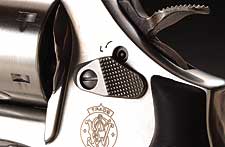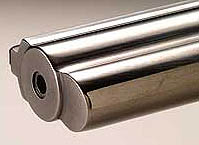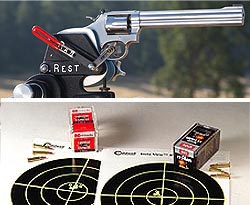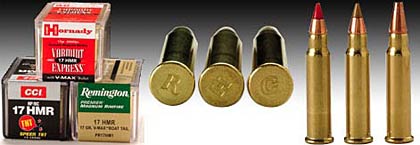September 23, 2010
By Rick Jamison
By Rick Jamison
The only rimfire cartridges most shooters have fired have been the .22s (or perhaps the 5mm Remington). But I used to hunt squirrels with a .25 Stevens rimfire, and no doubt others have used a .32 rimfire for the same task. The famous Henry rifle used a rimfire round, the .44 Henry Flat, way back in 1860, and the same round was chambered in Colt revolvers. At one time rimfire cartridges were available in many bullet diameters up through the .56-56 Spencer, which appeared in the hands of Union forces at the battle of Antietam in September 1862. But the heyday of those rimfire rounds had pretty much come and gone by the 1930s.
One reason those rimfire rounds faded from existence is because the case has a thin folded head that limits the pressures the case will contain. Thicker cases with solid heads are necessary for the pressures generated by modern centerfire rounds. Even so, the fact remains that by far more rimfire cartridges are sold in this country than any other sort of ammunition.
Advertisement
Today, the standard .22 Long Rifle forms the bulk of the rimfire sales while the .22 Magnum has offered a more powerful alternative. Hornady recently tapped into the high-volume rimfire market by loading a round with a smaller bullet — a 17-grain .17 caliber bullet — that is proving to be a hot-selling round. It's exceedingly accurate for rimfire ammunition. I've recently used several rimfire rifles from Marlin, Ruger, and Thompson/Center to shoot a variety of varmints, most recently prairie dogs. In a rifle, the .17 Hornady Magnum Rimfire (HMR) is more effective than the standard .22 Long Rifle cartridge and performs well on prairie dogs out to about to about 140 yards or so.
Another newer feature of the gun is the addition of Hogue rubber monogrips with molded-in finger grooves. The revolver has an 8 3/8-inch barrel with an extractor rod shroud running the full length of the barrel. The extra metal adds weight but perhaps stiffens the barrel. Also stiffening the barrel is a top rib. The outside diameter of the barrel is .710 inch at the muzzle, so it is plenty stiff for the small .17-caliber hole even without the shroud or top rib. In all, the long and heavy barrel makes the firearm feel muzzle heavy. On the one hand, I like a sidearm to have a barrel no longer than about 6.5 inches, but on the other hand, the .17 HMR cartridge benefits with a longer barrel to gain velocity and energy. Because of its barrel length, this revolver is best carried in a shoulder holster.
 The .17 HMR-chambered Model 647 features Hogue rubber grips, adjustable rear sights, and a key-actuated locking device located near the cylinder release thumbpiece. |
Model 647 Features
Advertisement
Smith & Wesson (Dept. ST, 2100 Roosevelt Ave., Springfield, MA 01104; 800-331-0852; www.smith-wesson.com) introduced the .17 HMR a few months ago in the Model 647, a double-action revolver made of stainless steel, and I received one of these guns for evaluation. The revolver is basically the standard medium-frame Smith & Wesson that we've been accustomed to for many years with the exception of an internal locking device with a key receptacle above the thumbpiece for the cylinder latch. It seems that a revolver lock could be a serious liability in the event that the gun were needed in a hurry. You can simply ignore the lock, but there is still an unsightly hole for collecting dirt. (There are a lot of warnings surrounding the use of the lock as well: "Never lock a loaded handgun, and never load a locked handgun. Never lock the handgun with the hammer cocked. Always open the cylinder and verify the revolver is unloaded and each charge hole is empty before unlocking the revolver.")
 Other nice features of the six-shot Model 647 are the heavy 8 3/8-inch barrel with full-length underlug and the recessed cylinder. |
The revolver shows its quality craftsmanship. The parts are all well finished and fitted. When you grip the gun, thumb back the hammer, and squeeze the trigger you get a feel for it. Everything is crisp and positive — cylinder rotation and lockup, crane swing and lockup, trigger, and hammer. The trigger lets off at just less than four pounds in single-action mode, but with the wide trigger and no discernible creep or overtravel, you would swear it is a lot less. The gun's relatively heavy (for a rimfire) 3.32-pound weight combined with the excellent trigger and target sights add up to something that can be fired accurately.
The sample S&W Model 647 is one of the most accurate revolvers I have ever fired. It produced a six-shot group average of 0.69 inch at 25 yards and fired a 1.4-inch six-shot string at 100 yards-from a Ransom Rest. Both groups were fired with Hornady ammunition.
Perhaps the single most important factor for the .17 HMR being such a success is the accuracy of the ammunition. The folks at Hornady really did their homework before introducing the cartridge. Aside from .22 match ammunition I do not think there is a more accurate rimfire cartridge in existence.
How The .17 HMR Performs
The round has performed very well in all the guns I've fired it in. Most have been rifles. Muzzle velocity for the .17 HMR from the S&W revolver is shown in the accompanying chart. It averages about 2100 fps, or about 450 fps slower than for the rifles I've fired it in. The rifles all had 22-inch barrels, or more than 2.5 times longer than the 647's barrel. And rifles do not have a barrel-cylinder gap to leak power. The Smith & Wesson's gap measures a close .005 inch.
 All three .17 HMR loads shot well with the Model 647 mounted in a Ransom Rest; the gun's best 25- and 100-yard groups came with the Hornady ammunition. |
Muzzle velocity from the ammo in this revolver is about the same as 75-yard impact velocity from a rifle. What it means is that any small varmint in range of the iron-sighted revolver is going to be hit with plenty of energy and bullet expansion for a quick demise. All this was verified by shooting several ground squirrels that expired almost instantly when hit by the tiny .17-caliber bullet from the revolver. Distances ranged from 20 to 50 yards. While the digger squirrels were taken cleanly, tissue damage was not excessive. That .17
HMR can easily be considered an edible small-game cartridge when fired from a revolver. The same cannot be said for rifles when shooting at short distances because tissue destruction becomes excessive for edible small game.
The revolver's cylinder is recessed for the cartridge case rims. One thing I noticed when I examined fired cases from the revolver is that the case shoulder is blown forward significantly (about .05 inch), which also causes the neck to be shortened by about the same amount when the round is fired. It is almost as if the S&W's chamber is "improved." The elongated chamber appears to have no detrimental effect on the performance of the firearm in any way that I could see. The rimfire cases headspace on the rim and not the shoulder.
| .17 HMR S&W Model 647 Accuracy & Velocity |
| Factory Load | | Muzzle
Energy
(ft-lbs) | 25-Yard Accuracy
(Inches) | 100-Yard Accuracy
(Inches) |
| CCI 17-gr. TNT HP | 2122 | 170 | 0.88 | 1.28 |
| Hornady Varmint Express 17-gr. V-Max | 2090 | 165 | 0.69 | 1.40 |
| Remington Premier 17-gr. V-Max | 2114 | 169 | 1.28 | 3.90 |
| NOTES: The revolver had an 8 3/8-inch barrel. All figures were collected with the Oehler Model 43 PBL and Skyscreens III. Accuracy at 25 yards is the average of three six-shot strings; 100-yard accuracy is for one six-shot string. Groups were fired with the revolver mounted in a Ransom Rest. |
 Rick tested the new revolver with Hornady, Remington, and CCI brand .17 HMR ammo. All had 17-grain bullets. |
While the Hornady ammunition shot the tightest groups, all the ammunition shot very well, probably better than I could shoot it from a revolver. The Hornady loading was the slowest, by a slight amount, and the CCI TNT was the fastest. This relationship proved true in four different tests, though the differences are so slight as to be negligible.
If you're looking for an accurate revolver, one that you can use to hone your shooting skill with rimfire ammo, the S&W Model 647 in .17 HMR is an excellent choice. Recoil is less than a half ft-lb from the revolver. To put it in simpler terms, you probably won't even notice that there is recoil. Muzzle blast is not as severe as many larger cartridges and what there is can be overcome with good hearing protection. To improve one's shooting ability, it is important that the firearm and ammunition be accurate. Only when the combination is accurate can you really see the result of a flinch or pulled shot, and also your shooting improvement over time.
For handgunners interested in a revolver to hunt small game or small varmints with, the S&W Model 647 is also an excellent choice. You can easily carry a lot of the small rimfire rounds, and I don't think you're likely to find a handgun with higher quality or better accuracy anywhere.
